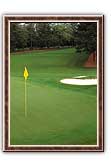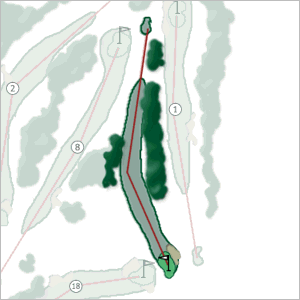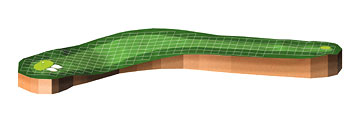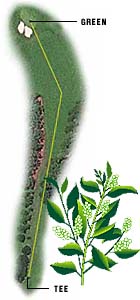| Hole Names | |
|
|
|

Hole #9Carolina CherryPrunus caroliniana Par 4, 435 Yards |

|
||
|
Best known for its green that slopes from back to front. The tee shot is often hit down the right side hoping to take away the two greenside bunkers on the left on the second shot to the green. Downhill, dogleg left. Second shot is uphill to a green that slopes sharply to the front. Downhill, dogleg left. Second shot is uphill to a green that slopes sharply to the front. Anything that lands on the front of the green likely will spin back 50 yards into the fairway. A downhill dogleg left, the second shot being to an elevated green on which it is difficult to judge just where the pin is located. | |||

QuickTime AVI (3.99M) Animated GIF | |||
|
Jack Nicklaus says: If you can hit a draw off the tee to get it to the bottom of the hill, it makes the hole so much easier to play a 9-iron or a wedge up the hill than it does a 5-iron or 6-iron from a downhill lie to an elevated green. I always feel that the first priority on the second shot is to make sure I don't spin off the front of the green. I'll worry if I have a downhill putt after that. The ninth hole has been difficult for me through the years. I play a natural fade and you need to draw the ball off the tee. Long hitters have a big edge here because they’re able to get the ball to the bottom of the hill where they can hit their second shot off a flat lie. That makes a big difference. The second shot is much more difficult when you’re left playing a 5- or 6-iron off a downhill, sidehill lie to an elevated green designed to receive a ball that’s been drawn. The obvious difficulty of the green is that it has three tiers. You want to avoid any downhill putts, so you need to hit your approach to the level where the flag is located. If the hole is back, you can even go to the right of the green because you can chip up the hill from there. My final-round birdie here in ’86 started me on a run in which I played the final 10 holes in seven under par. As I was setting up over my putt, I heard a roar from the crowd at No. 8. Both Seve Ballesteros and Tom Kite had just holed pitch shots for eagles. I turned to the gallery and said, “OK, let’s see if we can make a roar of our own here.” And we did. Fuzzy Zoeller says: There are trees on both sides of the fairway, so your drive must be accurate. Players will hit driver and then a 4, 5 or 6 iron to a three-level green. It's kind of soft, and the ball tends to roll back. This is a really good hole. Tiger Woods says: The best angle to come from approach-wise would be from the righthand side. Anything left off that tee is definitely a mistake. It is one of the more severe greens. You have three different shelves, and each one is very small and very distinct. Any ball above the hole, you'll see some guys playing some very unusual breaks. I've lined up with my back to the hole sideways. Anytime you make 4 there you're happy. Fred Couples says: This is another good driving hole. You try and turn it over a little and get it down the left side where you're left with a 9-iron or a wedge to the green. And if you do hit it to the right, there's no problem, but you have a much longer second shot -- maybe a 6- or 7-iron to a green that's pretty tough. If you come up short, the ball rolls all the way back down the fairway. And if you go long, you're left with a real tough putt. The front side is-in my opinion-harder to make birdies on because you don't make as many of them. But then if you do get to the back and you happen to birdie 10 or 11, you can really get going because you get a little confidence, and you've got the par-5s you can reach. That's why I think the front plays a little harder than the back. Bernhard Langer says: Players consider the ninth hole one of the more difficult tests at Augusta National because you have to hit a draw off the tee and then, unless you're a very long hitter, hit a short- to medium-iron shot from a downhill lie to an uphill green. An ideal tee shot calls for a bit of a draw, but you don't want to overdo it because a stand of trees between the first and ninth fairways can completely block you from the green. The putting surface features three plateaus. The green's first 10 yards slope severely toward the fairway. If you land there, your ball can easily spin back 30 yards down the hill. Unfortunately, that's happened to me a number of times. Even putting from above the hole is an adventure. A few years ago, I tried to trickle a putt from the top plateau to the bottom plateau and had to watch as the ball rolled 20 yards down the fairway. That was embarrassing. Ideally, you want to be short of the hole to give yourself an uphill putt. I personally find the first nine harder than the second, so I felt pretty good in 1993's third round when I had a 33 on the first nine and took the lead.
| |||

Hole #9Carolina CherryPrunus caroliniana Prunus caroliniana is a small native evergreen tree. The plant bears prolific clusters of small, white flowers in April followed by black berries which are popular with a variety of birds. |

|
||
fatpat Software · PO Box 1785 · Charlottesville, VA 22902 · (804) 977-1652
